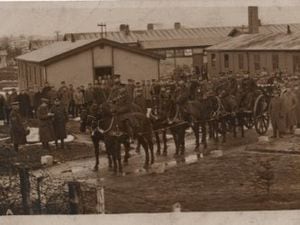Two years of masks, tiers and lockdowns
From social distancing to the rule of six. From furlough to plan B, with a variety of regional tiers in between.

Amid all the different rules, guidance and measures, it is easy to forget about Eat Out to Help Out, and the great ‘circuit breaker’ debate.
The coronavirus – the Covid-19 moniker was not introduced until February 11, 2020 – has loomed large in our lives ever since the first cases were revealed in Wuhan two years ago.
Since then there has been an ever-changing merry-go-round of restrictions and rules which have been introduced, relaxed, lifted and reimposed all within the space of a few weeks. No wonder the Boris Johnson has trouble remembering them all.
The first notable piece of guidance came on March 12, 2020, when the Prime Minister told anybody with a new cough or cold to stay at home for a week. The following Monday, March 16, Mr Johnson urged people to avoid “non-essential” contact with other people and travel. A week later, on March 23, Mr Johnson announced the first “lockdown”, under the slogan “Stay at home, save lives, protect the NHS”.
The laws came into effect on March 26, but at the time this seemed very much like a short-term measure. Mr Johnson had by this time assured the country that it could “turn the tide” on the virus within 12 weeks.
It was also the time the historic word “furlough” entered the modern lexicon, referring to a government support package for people unable to work during the lockdown.
Timeline of UK government coronavirus lockdowns and measures March 2020 - December 2021

Timeline of UK government coronavirus lockdowns and measures March 2020 - December 2021
Chancellor of the Exchequer Rishi Sunak announced that the Treasury would cover 80 per cent of the pay of workers who had been temporarily laid off as a result of the restrictions, in order to prevent mass redundancies.
While the lockdown was extended for a further three weeks on April 16, the situation still looked reasonably hopeful. On April 30, the PM said Britain had now passed the peak of the pandemic.
The following month, the Prime Minister introduced his “roadmap’ for the lifting of restrictions.
People who could not work from home would be allowed to return to the office or factory, but were told not to use public transport.
On June 15, non-essential shops would be allowed to reopen, the two-metre social distancing rule was reduced to one, and on June 23 the PM said the “national hibernation” was finally coming to an end.
Bars, pubs and restaurants were allowed to reopen on July 4, 2020, in a move that was quickly branded “Independence Day”.
Pubs and restaurants were subjected to restrictions though, including enforced social distancing, and a requirement for customers to remain seated.
Many installed glass screens between tables, and no more than two households could sit together indoors – although this did not apply outdoors. Gatherings in pubs and restaurants were also limited to a maximum of six people.
As the economy began to reopen, on August 3 Mr Sunak introduced a raft of new measures to support the construction and hospitality industries, which had been hardest hit by the lockdown.
He announced £2 billion worth of grants to make homes more energy efficient, and – more controversially – the Eat Out to Help Out scheme, which offered two-for-one deals in pubs and restaurants.
While Eat Out to Help Out was certainly popular, many dismissed it as a frivolous gimmick, with concerns that it would increase the spread of the virus.
Rising transmission rates and fears of a second wave let to a tightening of restrictions in September 2020. The ‘rule of six’ restricted the number of people who could meet, either indoors or outdoors, and people were once more told to work from home. Pubs and restaurants were ordered to close at 10pm.
A new series of local restrictions were introduced on October 4, where the rules depended on which tier the local authority had been placed in.
The tiers were determined by a complex formula, taking into account infection and transmission rates, the age-profile of those affected, and pressures on the NHS in the area.
In Tier 1 areas, the rules were almost unchanged, but in Tier 3 they were much tighter with pubs, restaurants and cafes ordered to close.
But it was the Tier 2 rules, which allowed pubs to open only for dining only, which caused the most controversy. Many found ingenious ways to circumvent the rules – including the infamous debate about whether a scotch egg or a plate of pork scratchings qualified as a ‘substantial meal’.
Mr Johnson initially resisted calls for a second, “circuit breaker” lockdown to counter rising infection rates, but on November 5 the restrictions returned, remaining in place for four weeks, after which the tiered system returned.
The following month it emerged that the rising number of cases was down to a new variant first detected on the Isle of Sheppey in Kent, and on December 19 a new, more stringent tier was introduced for London and the South East.
While the rules were relaxed a little over Christmas 2020, the respite was shortlived – with a third national lockdown on January 6, 2021. It would be almost three months until there was any significant relaxation of these restrictions, and non-essential shops would not reopen until April 12, followed by outdoor pubs and restaurants on May 17.
In September last year the Prime Minister said he had no plans for another lockdown, but instead proposed a series of measures, which he called “Plan B”, that would be introduced if the NHS came under sustained pressure.
The rules, including a return to working from home and the compulsory wearing of face masks in shops and other indoor venues came into force on December 10, following the discovery of the Omicron variant.
Now, as we enter 2022, there is hope that the chopping and changing in rules may be coming to an end. The requirement to wear masks has been dropped, isolation rules are less stringent and travel is opening up again to those those are fully vaccinated.
It is hoped we can start to live with Covid as an endemic virus, like flu. But don’t discount the possibility of more restrictions. The current fall in cases has already stalled as experts believe the virus is mutating into a more infectious form. That means yet more uncertainty, two years after Covid first arrived.





